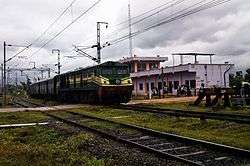Thirukural Express
Thirukural Express is a super-fast express train in India, running between Kanniyakumari, the southernmost tip of the Indian Subcontinent, and Hazrat Nizamuddin in New Delhi.
 | |||||
| Overview | |||||
|---|---|---|---|---|---|
| Current operator(s) | Southern Railways | ||||
| Route | |||||
| Start | Kanyakumari (CAPE) | ||||
| Stops | 24 | ||||
| End | Hazrat Nizamuddin (NZM) | ||||
| Distance travelled | 2,919 km (1,814 mi) | ||||
| Average journey time | 46:45 hours | ||||
| Service frequency | Bi Weekly | ||||
| Train number(s) | 12641 / 12642 | ||||
| On-board services | |||||
| Class(es) | AC Two Tier, AC Three Tier, Sleeper Class, Unreserved | ||||
| Seating arrangements | Yes | ||||
| Sleeping arrangements | Yes | ||||
| Catering facilities | Yes | ||||
| Observation facilities | Large windows | ||||
| Technical | |||||
| Rolling stock | ICF Coaches | ||||
| Track gauge | 1,676 mm (5 ft 6 in) | ||||
| Operating speed | 110 km/h (68 mph) maximum speed, 66 km/h (41 mph) average speed with halts | ||||
| Rake maintenance | Nagercoil | ||||
| Rake sharing | Kacheguda - Nagercoil Weekly Express | ||||
| |||||
It is currently a bi-weekly train covering a distance of 2,919 kilometres (1,814 mi), making it one of the longest-running super-fast trains in the country. The train shares a common route and timetable with the Tamil Nadu Sampark Kranti Express from New Delhi to Madurai.
Origin of the name
Thirukkural is a book of verses on common ethics and morality written by Tamil Poet Thiruvalluvar. The train was named after the statue of Thiruvalluvar in Kanniyakumari.
Timings
This train leaves Kanyakumari on Wednesday and Friday at 19:15 to reach Hazrat Nizamuddin at 18:00 on Friday and Sunday, respectively. It covers the total journey in 46 hours 45 minutes. In the return journey, it leaves Hazrat Nizamuddin at 07:15 on Monday and Saturday to reach Kanyakumari at 8:45 on Wednesday and Monday, respectively. It covers this journey in 49 hours 30 minutes (1 day 21 hours).
Route
This train runs, from Kanyakumari via Tirunelveli, Madurai, Trichy, Villupuram, Chennai Egmore, Vijayawada, Nagpur, Bhopal Junction, Jhansi Junction, Gwalior Junction, Agra Cantt to Hazrat Nizamuddin.
Traction
It is hauled by an Erode / Arakkonam based WAP 4 locomotive or Royapuram / Lallaguda-based WAP 7 locomotive on its entire journey.
